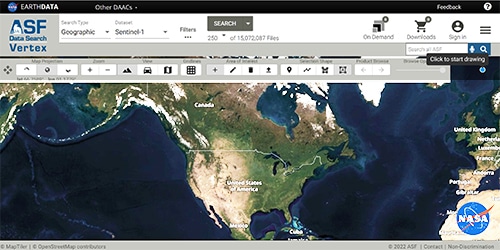Find your clues!
There are clues which tell us if a glacier has been over certain landscapes.
Think about it!
Imagine a landscape of mountains, trees, and wildflowers. Up in the mountains a glacier has been growing for some time and now begins to creep and flow over the land. What do you think happens?
Here’s a hint!
Imagine a bulldozer going over mountains, trees, and flowers. The bulldozer would definitely leave a mark and probably tear out the trees. Think of a glacier as a natural bulldozer.
Glaciers are Sculptors!
Glaciers sculpt and carve away the land, transport material, and create glacial landforms. A landscape can be dramatically re-shaped from a glacier’s passing. When glaciers carve and sculpt they are eroding the landscape. Eroding means to move dirt, rock, or other material from the ground. Boulders, broken rocks, and debris can be carried in and on the glacier ice and deposited far from their original locations. Sometimes the debris is even pushed ahead of a glacier and then left behind in mounds, or, rocks found at the end of a glacier may have come from the beginning.
Glacial landforms are clues to let us know where glaciers have been.
Glacier Landforms
Glaciated Valleys
Valleys with a U-shape, often with steep vertical cliffs. Sometimes entire mountains have been removed to create a U-valley.
Fjords
Long, narrow coastal valleys with steep sides and rounded bottoms. They were originally carved below sea level by their glaciers. After the glaciers left, sea water entered and covered the valley floors.
Cirques
Steep-sided basin-shaped depressions on a mountainside, carved out by a glacier.
Aretes
Sharp, narrow ridges formed by a glacier on a mountain.
Drumlins
Smooth rounded mounds of glacial till (rock, dirt, and debris) deposited under a glacier.
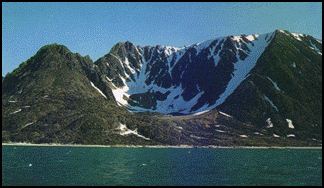
Kames
Steep-sided hills of sand and gravel deposited by glacial streams or in crevasses.
Horns
Steep-sided peaks, shaped like pyramids, formed when cirque glaciers erode on three or more sides of a mountain.
Tarn
A small lake filling a hollow which was eroded out by ice or dammed by a moraine. Frequently found with cirques.
Two Processes that Create Glacier Landforms
Erosion
Process by which material is worn away from the Earth’s surface.
fjords
glaciated valleys
horns
aretes
cirques
tarns
Deposition
The laying down of matter by a natural process.
till
moraines
kettles
boulders
drumlins
kames
A Kettle is the result of a very large block of ice being left behind as a glacier recedes. The melting forms potholes which are sometimes filled with water in a glacier, till, or outwash plain. Vegetation may grow up around kettles.
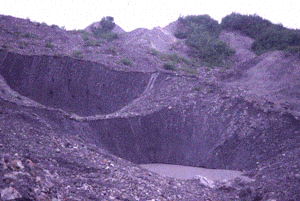

What about Valley Shapes?
If a glacier makes a U-shaped valley when it flows over the landscape, then what process makes a V-shaped valley?
Rivers! A river transports dirt and material (sediment). If a river has more energy than it needs to transport its load of sediment, it will use that energy to cut downward, eventually creating a V-shaped valley.
A river will follow the path of least resistance. A glacier will force its way through almost anything. Rivers and glaciers each transform the landscape, but in different ways. Look at the three pictures. What differences do you see?
As you might guess from its name, a V-shaped valley has different slopes than a U-shaped valley. A U-shaped valley has gentle, over-steepened slopes. Also, stream or river-cut V-shaped valleys may meander and curve, while glacier U-shaped valleys are straighter in their course.

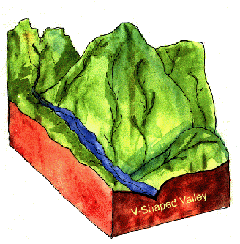

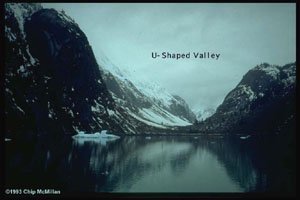
Something to think about:
Glaciers are made of ice and rivers are made of water. Think of a solid then a liquid. At home, pour some water over an old rock, then rub a piece of ice over the rock with some pressure. What differences do you think there will be between the two processes?
Why do we want clues to find out where glaciers have been?
What we see today gives us clues of what happened in the past. For two million years, North America, Europe, and Asia were covered in ice sheets. Glaciers were everywhere. As the temperatures got slightly warmer, these glaciers began to melt.
World Detectives
Now, we only see glaciers where the temperature and precipitation is just right. As we learn more and more about glaciers, we realize that glaciers leave clues about where they’ve been. Geologists and glaciologists are world detectives who put pieces of the big Ice Age puzzle together to find out what happened in the past. The puzzle pieces also help determine what may happen in the future. Cool!
Glaciologists learn to spot clues glaciers leave behind. They can tell if the glacier has been in the area.
Has a glacier been where you live?
CLUES:
Scraped Rock
Silt
Valley with a U-Shape
Huge Boulders
Cirques
Fjords

The image above is an example of a glacier clue! It’s a 60-ton boulder left behind by a glacier. Many such large surface boulders are scattered across the upper Midwestern United States and in other areas where glaciers have been. These boulders are called erratics which is derived from a Latin word which means, “to wander.” The boulders have “wandered” from their original place.
Glacier Detectives – Remember:
Check to see if a valley is U-shaped or V-shaped because that will be a special clue as to “where a glacier has been.” Be a detective with us and discover the clues glaciers leave behind! Here’s a warm-up for detective work you can do later on!
A Glacier Power Warm-up!
There is a U-shaped valley and huge boulders are lying all over the landscape. How did those huge boulders get there? Well, I bet a bulldozer could plow them down the landscape. Remember, a glacier is similar to a bulldozer so a glacier must have transported those boulders.
Where have Glaciers Been?
Vocabulary Plus!
U-shaped valleys
V-shaped valleys
erosion
deposition
horns
kames
drumlins
aretes
cirques
fjords
glaciated valleys
Review Questions
(some of the answers may come from the vocabulary list)
- What three continents were covered in ice sheets for 2 million years?
- What made the glaciers melt two million years ago?
- Why do geologists and glaciologists study the Ice Age?
- Do glaciers leave clues behind? Yes or No?
- Name two clues that glaciers leave.
- What two things have to be just right for a glacier to exist?
- What does deposition mean?
- What does erosion mean?
- What is the difference between a U-shaped valley and a V-shaped valley?
Brain Challenge
Have glaciers been around where you live? How can you tell?
Exercise: Connect the Related Words
U-Shaped Valley
V-Shaped Valley
river
glacier
silt
fjords
Grand Canyon
Project: See How Types of Valleys are Formed
You will need:
- A milk jug full of water
- Several ice cubes
Find a slope or side of a hill outside. (Or make your own by mounding dirt, gravel, and thick mud into a “hill” in the bottom of a plastic-lined box. Let dry). First, pour a thin stream of water from the jug down the slope. Empty the jug in this way. Can you see how the water meanders in a thin stream? Think about how rocks and sediment would move freely if caught in a stream of water. Water causes a V-shaped valley to form by wearing land down over time.
Second, take an ice cube and scrape it down the slope along another path. See how it pushes dirt and other material out of its way? A glacier is like a chisel; it creeps and carves its way along the ground, leaving a U-shape in its wake.
(Courtesy Glaciers of North America, By S. Ferguson)


